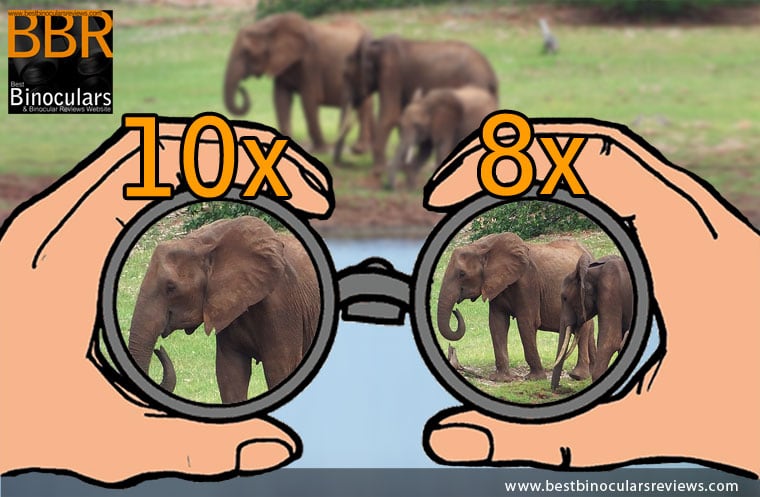![High Power Binoculars]()
The questions below are my answers to readers who are looking for a pair of high powered binoculars for long distance viewing and include some advice as well as options and recommendations as which high powered binoculars are best depending on the exact application:
![Have A Question For Me?]() Question 1:
Question 1:
I have a question about which binoculars to buy. The main purpose, is to scan the hill on the opposite side of the loch, which is about a mile away and the mountains behind the house.
I have an old pair of Zeiss Dialyt 10x40B which are wonderful but I would like something that would zoom in more/see further.
I was told that the first figure is the magnification so should be much better than the Zeiss by a friend who gave me a pair of Bushnell 20×40 that they bought in 2006. They are rubbish! can’t really get them setup properly and when they are as good as they get the view looks the same from them as it does with the Zeiss which are a breeze to use.
Any advice and or suggestions would be really appreciated.
![Have A Question For Me?]() Question 2:
Question 2:
I think you website is a fantastic source of information and I would really appreciate your opinion on a pair of high power binoculars.
I already have 2 average/good quality compact binoculars (10 x 25) and would like something a bit more powerful (say) around 12-15x or possibly up to 20x. Brightness, optical & build quality is important and my budget upper limit would be approx USD400.
I live on the coast in Australia and can view migrating whales from my house. They are usually 2,000-5,000m away with most being 3,000m. I am interested in seeing the whales as closely as possible without needing a tripod although the ability to use them with a tripod is desirable.
The new binoculars would primarily be used at home and we would use our existing compact ones when we are walking.
Can you please advise on some suitable bins and also whether I should also be considering more powerful IS ones? Any help would be greatly appreciated.
Answer
Thank you very much for the questions, which I will try to answer to the best of my knowledge:
Firstly your friend is right in saying when describing a binocular, the first number is the magnification, so your Zeiss Dialyt 10x40B has a magnification of 10x, whilst the Bushnell 20×40 will magnify the image a massive 20x.
If you need more info on this, take a look at my page on What To Look For When Buying Binoculars that includes a section explaining all about what the numbers mean.
What they are not correct in assuming is that a larger magnification on powerful binoculars will be "much better" than a smaller one. Remember, the most powerful binoculars are not always the best option and there are many other factors to consider when choosing long distance viewing binoculars:
Magnification & The Exit Pupil
I am not surprised that the 20×40 Bushnell’s that your friend gave you were difficult to use as they produce an exit-pupil that is only 2mm in diameter (40 ÷ 20 = 2mm). This is tiny and is smaller that the size of the pupil in your eyes, even in good light during the day when your pupils are at their smallest.
Taking your Zeiss Dialyt 10x40B as another example, they produce a much more respectable 4mm exit pupil (40 ÷ 10 = 4mm), which will be larger than your eyes pupils in good light.
What this means is that not only is the Bushnell binocular transmitting less light to your eyes than those like your Zeiss binoculars with a larger exit pupil and so will appear less bright, but it makes lining up your pupils with those very small (2mm) shafts of light much more difficult than ones that produce larger shafts of light (larger exit pupils). If you do not line up your eyes with this light, you get dark rings forming around the image and it generally makes viewing the image very difficult.
For more on this very important concept to understand, please read my guide to the exit-pupil.
Objective Lens Size
Larger Objective Lenses
So as you can see by simply increasing the magnification on a binocular and nothing else, the exit pupil will get smaller and smaller. To counter this and make sure you get binocular that produces an image that is bright enough as well as easy to use, you need to increase the size of the objective lenses. These will have the potential to let in more light and therefore create a larger exit pupil, which can deliver more light to your eyes.
So if for example you kept the 20x power, but had a binocular with objectives twice the size (80mm), they would now produce a shaft of light that is 4mm in diameter (80 ÷ 20 = 4mm), which is much more reasonable and in fact is the same as your 10×40 Zeiss.
The main potential down side to this is as you increase the objective lenses, the larger and heavier your binoculars become. A typical 20×80 binocular will weigh around 2kg (4.4 pounds/ 70.4 oz) and so can be quite difficult or even impossible to hold steady for a reasonable amount of time. To counter this, you should mount them onto a tripod, which will also prevent the increased image stability, which I will get to a little later.
Almost all giant binoculars come with integrated tripod adapters that make attaching them to your tripod very simple – for more, see the section on tripods below.
Magnification & FOV
Whilst powerful binoculars give you more image detail, another down side to increasing the magnification on a binocular or indeed almost any other optical device is that it reduced the field of view (FOV) or to put it more simply the width of the image that you can see gets narrower. This can make locating and following an object more difficult and is also not ideal if you want to scan over a wide area looking for something as at any point you are viewing a smaller area than a binocular with a wider FOV.
If we consider that most full sized 10×42 binoculars have a FOV of between 300ft and 350ft wide at a distance of 1000ft, you can see that the FOV of the much higher powered bins I have listed below is greatly reduced.
Magnification & Image Steadiness
As the magnification of an optical instrument is increased, any movement you make is amplified even more and so it makes keeping the image steadier more and more difficult. For hand held devices you really do not want to go much above 15x – 16x.
So whilst it is possible to hand hold a binocular at higher magnifications, the constant image shake will make it hard to get a good view of whatever you are trying to observe, especially over longer periods and so you may find that you need to support the bin against a post or tree.
Tripods
So if you want to use a high powered long distance binocular, you really should attach them to a good tripod via a tripod adapter. Fortunately most giant binoculars and many larger bins will come with integrated tripod adapters that makes them really simple to fix securely to your tripod and even if they don’t they are an easy to find and relatively cheap accessory to purchase. If you are wondering which to get, I personally use this Vanguard Alta Pro 263AT Tripod that I highly recommend, but there are many, many others that I am sure will work just as well.
Image Stabilisation Binoculars
Binoculars like the excellent range Canon IS Binoculars, use electronics to stabilise the image which works really well. On the down side, the added electronics makes these a little heavier and more costly.
Recommended High Powered, Long Distance Binoculars
Price
There are few low cost options available, which I have listed below, but just remember that in life you usually get what you pay for. So whilst they will be better than not using any binoculars at all, generally the more you pay, the better quality prisms, lenses and optical coatings are used, which will all go a long way to improving the overall quality of the image that you see and so the best long distance binoculars also tend to be the more expensive options.
50mm High Powered Binoculars
Hand Held Option: The 50mm recommendations listed below may not have the longest range, but they are for those who are want a higher magnification binocular, but don’t necessarily want to have to attach it to a tripod.
Note: Most will still be tripod adaptable, giving you the flexibility to use them as you wish depending on the circumstance. Indeed just how far can you see with 10×50 binoculars will be greatly affected by how steady you can keep the image.
So for example it may be nice to have them permanently set-up on a balcony looking out to the ocean on a tripod and then if you wish to take them out with you, just remove them from the tripod and off you go.
Nikon & Pentax 16×50 Binoculars
![Nikon 16x50 Aculon A211 Binocular]() Both Pentax and Nikon produce a number of different porro prism models, in a range of prices with this 16×50 configuration, which I feel is ideal for a higher power hand held optic for most uses:
Both Pentax and Nikon produce a number of different porro prism models, in a range of prices with this 16×50 configuration, which I feel is ideal for a higher power hand held optic for most uses:
The size and weight is not so great as to make them too awkward to use for long periods and the slightly reduced magnification of 16x makes it much easier to keep the image still without the aid of a tripod.
Pentax 16×50 XCF Binoculars
The XCF is their higher end product in this size configuration and uses Pentax’s Super Multi-Coating for an improved light transmission.
Note: Whilst they don’t come with a tripod adapter included, they are tripod adaptable.
- Field-of-View 183ft @ 1000 yd / 61m @ 1000m
- Weight 1.98lb / 900g
- Dimensions 7.80 x 6.54 x 2.20" / 19.8 x 16.6 x 5.6cm
Nikon 16×50 Aculon A211 Binoculars
With Multicoated optics and the porro prism design, the Nikon Aculon binocular looks to me to be a good lower cost option for those on a budget. Also worth noting that considering their 16x power these have a good field of view:
- Field-of-View 220 ft@ 1000 yd / 73m @ 1000m
- Weight 32.6oz / 924g
- Dimensions 7.8 x 7" / 19.81 x 17.78cm
![Pentax 16x50 S-Series SP Binoculars]() Pentax 16×50 S-Series SP Binoculars
Pentax 16×50 S-Series SP Binoculars
This is the cheap option, but still use Porro Prisms made from BaK-4 glass and have Fully Multicoated Optics which is good news.
- Field-of-View 183ft @ 1000 yd / 61m @ 1000m
- Weight 32oz / 907g
- Dimensions 7.8 x 6.5 x 2.3" / 19.8 x 16.5 x 5.8cm
Price Range
As I mentioned earlier, both Nikon and Pentax have a number of different options within the 16×50 configuration ranging in price from around $80 up to $200 in the US and £80 – £200 in the UK.
60mm – 80mm High Magnification Binoculars
Possible Hand Held Options: Whilst I have listed these high range binoculars below that can be hand held if you don’t want to use a tripod, you will still get a better experience if you attach them to a tripod using a tripod adapter as it will not only ensure a steadier image but give your arms a rest if you spend long periods scanning wide areas:
Celestron SkyMaster 25×70 Binoculars
![Celestron SkyMaster 25x70 Binoculars]() The 25x70mm Celestron SkyMaster binoculars combine a very high powered 25x magnification with large 70mm objective lenses and whilst the can be attached to a tripod for the most stable views, they are just light and small enough for most people to be able to hand hold them.
The 25x70mm Celestron SkyMaster binoculars combine a very high powered 25x magnification with large 70mm objective lenses and whilst the can be attached to a tripod for the most stable views, they are just light and small enough for most people to be able to hand hold them.
The FOV on these is 141 wide @ 1000 yards (47m @ 1000m), which for a binocular with such a high power is pretty impressive.
Read My Full Review for all the details on what I believe is a great low cost long distance binocular for use during the day and a good astronomy binocular at night.
Price Range
At the time of writing, the Celestron SkyMaster 25×70 Binoculars were available for around $90 in the US and £80 in the UK, which makes them great value for money.
Celestron Echelon 20×70 Binoculars
![Celestron Echelon 20x70 Binoculars]() This award winning Echelon is similar to that of the SkyMaster above, except where the SkyMaster focuses on being great value for money, the Echelon’s main aim is simply to be the best and indeed these are up there with the best long distance binoculars that I have tested.
This award winning Echelon is similar to that of the SkyMaster above, except where the SkyMaster focuses on being great value for money, the Echelon’s main aim is simply to be the best and indeed these are up there with the best long distance binoculars that I have tested.
All Celestron Echelon binoculars are put together by hand in the USA, but they use the best optical components imported from Japan, thus combining a very high build quality with exceptional quality glass and coatings, to produce a stunning instrument.
Scoring an "outstanding" 82% when I reviewed them they performed well above average in every department. Highlights include a full water and fogproof aluminium tripod adaptable body, BaK-4 porro prisms and Fully Multi Coated optics.
Whilst these 20x binoculars are not quite as powerful as the SkyMaster above, but the advantages being that you get a bigger exit pupil, for a much better low light performance and a wider field of view: The FOV on these is 157 wide @ 1000 yards (52m @ 1000m).
For more details, please take time to Read My Full Review of this exceptional instrument.
Price Range
Costing around $800 in the US, they are not the cheapest, but when you consider the additional quality, I do still believe they make good value for the discerning long distance observer.
Pentax 20×60 PCF WP II Binoculars
![Pentax 20x60 PCF WP II Binoculars]() These high powered long distance binoculars with their 60mm objectives have a exit pupil of 3mm, which should be just enough for day time observation. They also use Pentax’s Super Multi Coated lenses to increase the transmission levels to around 98%, which will help with image brightness.
These high powered long distance binoculars with their 60mm objectives have a exit pupil of 3mm, which should be just enough for day time observation. They also use Pentax’s Super Multi Coated lenses to increase the transmission levels to around 98%, which will help with image brightness.
They weigh 3.09lb / 1.40 kg, which is a lot lighter than the larger 80mm binoculars listed below and so is possible to hand hold. However to keep the image completely steady over longer periods you may need to use something like a post or a tree if you don’t want to use a tripod.
The FOV on these is only 114ft wide @ 1000 yards (38m @ 1000m), which may be a consideration if you need to scan large areas.
Price Range
The Pentax 20×60 PCF WP II Binoculars cost about $200 in the US and £220 – £300 in the UK.
Nikon Monarch 5 20×56 Binoculars
![Nikon Monarch 5 20x56 Binoculars]() These very high quality, high powered binoculars from Nikon are a great option and possibly my favorite choice if you are looking for a binocular that can be hand held as well as attached to a tripod as they weigh just 1.2kg (43.5 oz).
These very high quality, high powered binoculars from Nikon are a great option and possibly my favorite choice if you are looking for a binocular that can be hand held as well as attached to a tripod as they weigh just 1.2kg (43.5 oz).
Whilst they only have 56mm objectives, they come with a host of very high end optical features to improve image quality and boost the brightness. This includes: Extra-low dispersion (ED) glass, phase corrected Bak-4 roof prisms that also have dielectric high-reflective coatings and all lenses and prisms are fully-multilayer-coated.
The FOV on these is an impressive 174ft wide @ 1000 yards (58m @ 1000m), which is a lot better than many others with this amount of power.
Price Range
The Nikon 20×56 Monarch 5 binoculars cost about $850 – $900 in the US and £700 in the UK.
Giant Binoculars – 80mm+
Giant high zoom binoculars, with objective lenses of around 80mm like some of those listed below are commonly used for astronomy as they have large objective lenses to let in as much of the little light that is available and have a high magnification to bring distant objects like the moon, stars and galaxies into closer view. However this does not mean that they can’t be used as effectively as a terrestrial long distance binoculars.
Low Cost Giant Binoculars:
Zhumell 20×80 SuperGiant Binoculars
![Binoculars.com's Best Astronomy Binocular 2012 - Zhumell 20x80 SuperGiant Binoculars Binoculars.com's Best Astronomy Binocular 2012 - Zhumell 20x80 SuperGiant Binoculars]() Winner of Binoculars.com’s award for the Best Astronomy Binocular in 2012, the Zhumell 20×80 SuperGiant Binoculars are a pretty good option if you are looking of a cheap, but high powered binocular.
Winner of Binoculars.com’s award for the Best Astronomy Binocular in 2012, the Zhumell 20×80 SuperGiant Binoculars are a pretty good option if you are looking of a cheap, but high powered binocular.
Despite their giant 80mm objectives, they have kept the weight down to 70.4 oz. / 4.4 pounds / 2kg, making them just small enough to use in the field, but of course are best mounted to a tripod.
The FOV on these is 168 ft wide at 1000 yards away
They also feature fully multi-coated optics and BaK4 prisms, and custom adjustment with center and right diopter focus knobs. Perfect for lunar viewing, locating deep space objects, or as you need, long range terrestrial viewing.
Price Range
Zhumell SuperGiant 20×80 Binoculars cost about $100 in the US, but are a little harder to find in the UK.
Celestron SkyMaster 20×80 Binoculars
![Celestron SkyMaster 20x80 Binoculars]() Like the Zhumell’s above, these have a powerful 20x magnification combined with 80mm objective lenses to produce a 4mm exit pupil. The also use high quality BAK-4 prisms, but they only come with Multi-Coated optics as opposed to the Fully Multi-Coated ones on the Zhumell’s. Having said that they are a fraction of the price when compared to high spec giant binoculars and will still produce a more than decent view during the day.
Like the Zhumell’s above, these have a powerful 20x magnification combined with 80mm objective lenses to produce a 4mm exit pupil. The also use high quality BAK-4 prisms, but they only come with Multi-Coated optics as opposed to the Fully Multi-Coated ones on the Zhumell’s. Having said that they are a fraction of the price when compared to high spec giant binoculars and will still produce a more than decent view during the day.
Weighing 75 oz (2126 g), they have a FOV of 167 ft. at 1000 yards.
If the 20×80 configuration is not right for you, Celestron produce the Skymaster in a range of different setups:
Price Range
Celestron Skymaster 20×80 Binoculars cost about $100 in the US and about £100 in the UK:
Mid-Level Giant Binoculars:
Zhumell Tachyon 25×100 Binoculars
![Binoculars.com's Best Astronomy Binocular 2013 - Zhumell Tachyon 25x100 Astronomy Binoculars]() If you are looking for even more power a good mid-cost option would be these Super Giant Zhumell Tachyon binoculars with their massive 25x magnification and 100mm objective lenses that produce an exit pupil of 4mm.
If you are looking for even more power a good mid-cost option would be these Super Giant Zhumell Tachyon binoculars with their massive 25x magnification and 100mm objective lenses that produce an exit pupil of 4mm.
Winner of the award for the Best Astronomy Binocular in 2013 at Binoculars.com, the optics on the Tachyon include the use of BaK4 prisms and fully multi-coated lenses and they have a relatively wide FOV of 157 ft. @ 1000 yards.
Their weight is 4.7kg (164.8 oz.) and so as you can see you will definitely be needing a tripod!
Price Range
Zhumell 25×100 Tachyon’s cost about $240 in the US.
Barska 20x80mm Cosmos Binoculars
![Barska 20x80 Cosmos Binoculars]() The Barska 20×80 Cosmos uses BAK-4 prisms combined with fully multi-coated optics, and a large 80mm objective lens to allow for maximum light transmission and clear, crisp imaging.
The Barska 20×80 Cosmos uses BAK-4 prisms combined with fully multi-coated optics, and a large 80mm objective lens to allow for maximum light transmission and clear, crisp imaging.
These fully waterproof, heavy-duty, binoculars are ideal for long-distance and astronomy viewing, they have a braced in tripod mounting post allows for quick and easy setup. Whilst these use a lightweight and high quality aluminium body, they still weigh 2.5kg (88 oz).
Field of view is 157 ft. wide at 1000yards.
Price Range
The Barska 20x80mm Cosmos Waterproof Binoculars cost about $200 – $250 in the US:
High Powered Binoculars at Night
![Have A Question For Me?]() Question 3:
Question 3:
I’m 70, still can’t figure out the social platforms you mentioned – sorry.
Absolutely love the web site. Clear, concise, good balance on color changes and fonts that old people can see. Pretty amazing.
Single recommendation if possible – please – thank you. We retired to Las Vegas, just built a new house up the side of Black Mountain. Entire Las Vegas valley below us. Strip and downtown about 8 miles away. Would like best binoculars and tripod for night viewing. View is fantastic. Thinking of the Fujinon 12×60 on tripod. What would you get – thanks again
Answer
![Fujinon HB 12X60 Binoculars]() Hi Ryan, many thanks for your question and the kind words.
Hi Ryan, many thanks for your question and the kind words.
Whilst I have not had the opportunity to test the Fujinon 12×60, I don’t think you will go far wrong with them as I have heard only but good things about the brand in relation to long distance, larger objective binoculars.
The only thing I have reviewed that is similar to these and which I may recommend are the Celestron Echelon 20×70 Binoculars (see above or Read My Full Review here), which are in my opinion excellent.
However as you are planning on using your long distance binoculars mostly for night, I think you are right in keeping the magnification down to a reasonable amount, to maintain the exit pupil size. Whilst not the case for everyone, I think this is even more important when we consider your age, where your pupils may not dilate as much as when you were younger. For more on this please take time to read my complete guide to the exit pupil which goes over it all in detail.
I hope this helps and I would love to know what you do eventually get and how they perform for you.
![Swarovski-Spotting-Scope]()
Spotting Scopes
Another option would be to get a spotting scope which are in their most basic form, telescopes designed for terrestrial observation.
These generally have higher magnifications than even the strongest binoculars and come with larger objective lenses for the reasons that we have already discussed. The down side is that they only have one eye-piece (the are essentially half a binocular). Whilst this saves weight and makes them smaller, but in general I feel that a good quality high power binocular is easy to use, provides a better view and to me offers improved comfort, especially during extended periods of use than most spotting scopes.
If this option interests you, take a look at the Best Spotting Scope Reviews Website that includes much more information as well as reviews on a selection of spotting scopes that I have used.
Further Reading:
I hope that at least some of the advice I have given is useful and that you are able to find the right long distance viewing binoculars for your needs and within your budget. If you or anyone else has any more questions related to this topic, please don’t hesitate to ask it in the comments section at the bottom of this page.
![Have A Question For Me?]() Need Advice?
Need Advice?
If you have a question relating to binoculars, or just want to know more about a specific technical optical term, then I would love to try and answer it for you. Submit your question here.
![Share]()
The post High Powered, Long Distance Viewing Binoculars appeared first on Best Binocular Reviews.
![]()

![Have A Question For Me?]() Question:
Question:![]() ). So, I am already expecting that you would probably point me out 2 different models, dedicated to each situation (but, still… Would be great to get it all in one gear…). Of course, I am not rich enough, so I was expecting to spend about US$200-300 on Daily binocular, and about US$300-400 on Nightvision. So, an all-in-one device about $700 is also totally acceptable.
). So, I am already expecting that you would probably point me out 2 different models, dedicated to each situation (but, still… Would be great to get it all in one gear…). Of course, I am not rich enough, so I was expecting to spend about US$200-300 on Daily binocular, and about US$300-400 on Nightvision. So, an all-in-one device about $700 is also totally acceptable.  Sure you will often see some very cheap binoculars on places like Ebay, Walmart and Aliexpress advertised as being both Day and Night binoculars and which usually have red or gold tinted objective lenses (click on the image on the right for some examples).
Sure you will often see some very cheap binoculars on places like Ebay, Walmart and Aliexpress advertised as being both Day and Night binoculars and which usually have red or gold tinted objective lenses (click on the image on the right for some examples).  Here it is important to understand that true night vision devices that amplify the very small amounts of light available at night to produce an image (that is often green or grey) by using either intensifier tubes and phosphor screens or achieve it digitally are very different to your optical only binoculars (even those that have very good low light capabilities). If you are not sure what I mean here, take a look at this guide to Night Vision Binoculars, Monoculars & Other Devices.
Here it is important to understand that true night vision devices that amplify the very small amounts of light available at night to produce an image (that is often green or grey) by using either intensifier tubes and phosphor screens or achieve it digitally are very different to your optical only binoculars (even those that have very good low light capabilities). If you are not sure what I mean here, take a look at this guide to Night Vision Binoculars, Monoculars & Other Devices.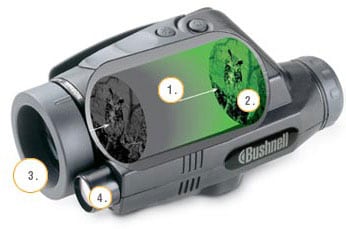 Digital or Conventional Night Vision?
Digital or Conventional Night Vision?![Luna Optics LN-DM50-HRSD Digital Night Vision Viewer/ Recorder]() Suggestions
Suggestions![Luna Optics LN-DM5 Night Vision Monocular]() Less Expensive Option
Less Expensive Option
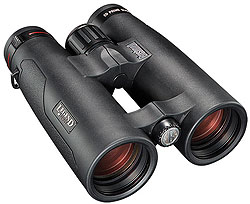 Which to choose?
Which to choose? Otherwise my personal preference for safaris would be to opt for a mid-sized binocular that balances a more than decent low light performance with a slightly smaller body size and weight
Otherwise my personal preference for safaris would be to opt for a mid-sized binocular that balances a more than decent low light performance with a slightly smaller body size and weight![Have A Question For Me?]() Need some BinoWizard Advice?
Need some BinoWizard Advice? Question:
Question: Suggestions
Suggestions Less Expensive Option
Less Expensive Option





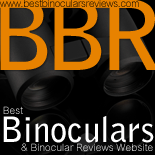 Although I have not tested or reviewed these Bushnell’s on BBR, we can take a look at some of the facts to draw up some sort of an opinion to see if they are worth considering:
Although I have not tested or reviewed these Bushnell’s on BBR, we can take a look at some of the facts to draw up some sort of an opinion to see if they are worth considering: BBR Alternatives:
BBR Alternatives:





 BBR Alternative:
BBR Alternative:


 BBR Alternative:
BBR Alternative:

 Main Features & Specifications:
Main Features & Specifications:




 If size is not a major concern and if you are after a great all-round binocular for older children (and adults) then I highly suggest you take a look at the 8x42 Meade Rainforest Pro Binoculars:
If size is not a major concern and if you are after a great all-round binocular for older children (and adults) then I highly suggest you take a look at the 8x42 Meade Rainforest Pro Binoculars: For a slightly smaller binocular, with an open bridge body that will make it easier for smaller hands to carry and hold onto then look no further than the Opticron 8x33 Savanna 8x33 Binoculars, that offer incredible vale for money:
For a slightly smaller binocular, with an open bridge body that will make it easier for smaller hands to carry and hold onto then look no further than the Opticron 8x33 Savanna 8x33 Binoculars, that offer incredible vale for money: Currently on sale for about $70 / £80, these inexpensive
Currently on sale for about $70 / £80, these inexpensive  Costing less than $90 / £90, these compact Vanguard binoculars are under budget, small and lightweight.
Costing less than $90 / £90, these compact Vanguard binoculars are under budget, small and lightweight.





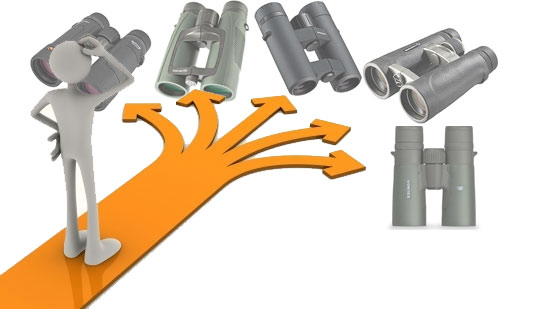
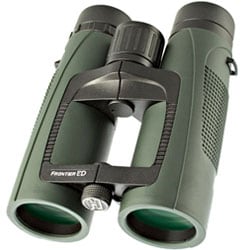
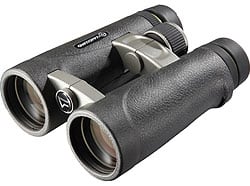




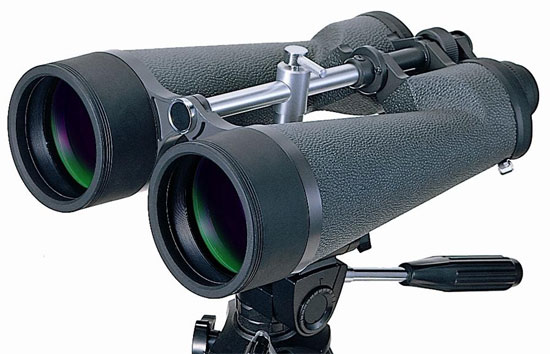





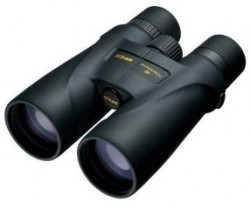
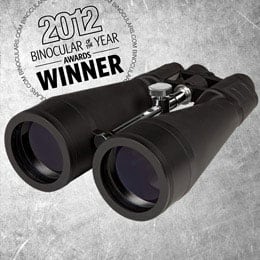 Winner of Binoculars.com’s award for the Best Astronomy Binocular in 2012, the Zhumell 20×80 SuperGiant Binoculars are a pretty good option if you are looking of a cheap, but high powered binocular.
Winner of Binoculars.com’s award for the Best Astronomy Binocular in 2012, the Zhumell 20×80 SuperGiant Binoculars are a pretty good option if you are looking of a cheap, but high powered binocular.
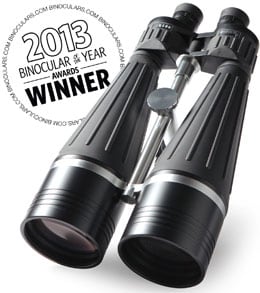 If you are looking for even more power a good mid-cost option would be these Super Giant Zhumell Tachyon binoculars with their massive 25x magnification and 100mm objective lenses that produce an exit pupil of 4mm.
If you are looking for even more power a good mid-cost option would be these Super Giant Zhumell Tachyon binoculars with their massive 25x magnification and 100mm objective lenses that produce an exit pupil of 4mm.  The Barska 20×80 Cosmos uses BAK-4 prisms combined with fully multi-coated optics, and a large 80mm objective lens to allow for maximum light transmission and clear, crisp imaging.
The Barska 20×80 Cosmos uses BAK-4 prisms combined with fully multi-coated optics, and a large 80mm objective lens to allow for maximum light transmission and clear, crisp imaging. Hi Ryan, many thanks for your question and the kind words.
Hi Ryan, many thanks for your question and the kind words. 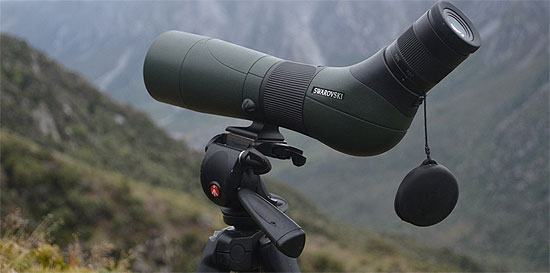


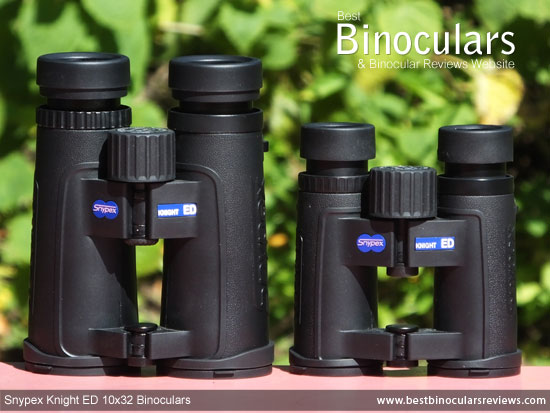


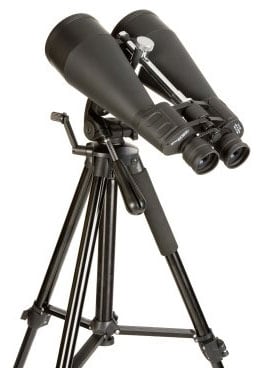 If you keep the same objective lens size (say 42mm for example), but you increase magnification, the image may seem to become less bright to you and this is more obvious in poor light like at dawn and dusk or when birding in a deep forest. This is down to how the size of objective lens and magnification control the size of the
If you keep the same objective lens size (say 42mm for example), but you increase magnification, the image may seem to become less bright to you and this is more obvious in poor light like at dawn and dusk or when birding in a deep forest. This is down to how the size of objective lens and magnification control the size of the 

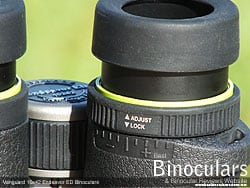
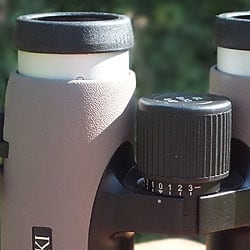 Dioptre Adjustment Range on Binoculars
Dioptre Adjustment Range on Binoculars

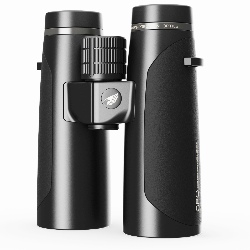


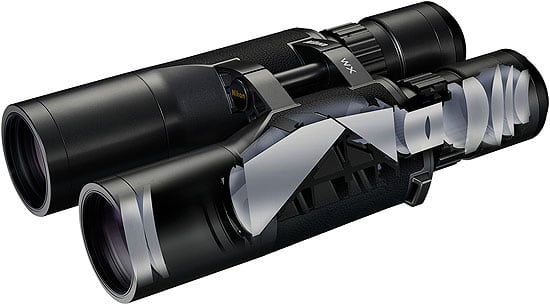
 Easier Eye Alignment
Easier Eye Alignment




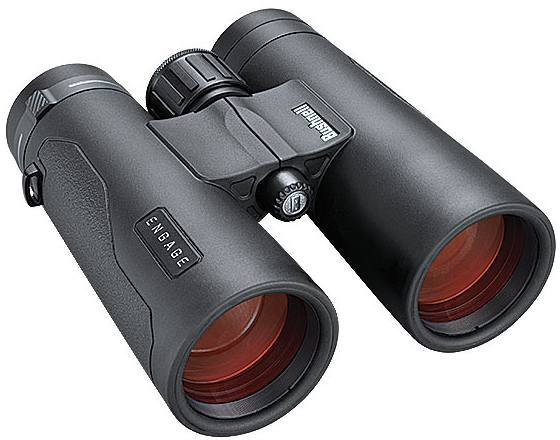


 Simon mentions that in the past he has always tended to go for a binocular with a 7x or 8x magnification. This sounds logical to me and nothing wrong with that, but his reason for not selecting a 10x one is somewhat misguided: He says "Higher magnifications tend to be heavier and therefor harder to hold for prolonged periods in the field, you get a wobbly image".
Simon mentions that in the past he has always tended to go for a binocular with a 7x or 8x magnification. This sounds logical to me and nothing wrong with that, but his reason for not selecting a 10x one is somewhat misguided: He says "Higher magnifications tend to be heavier and therefor harder to hold for prolonged periods in the field, you get a wobbly image". A few examples include the very high specification
A few examples include the very high specification 

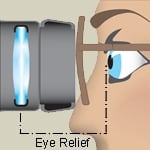 What is eye relief?
What is eye relief?
